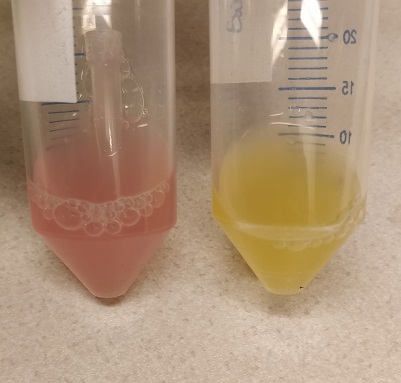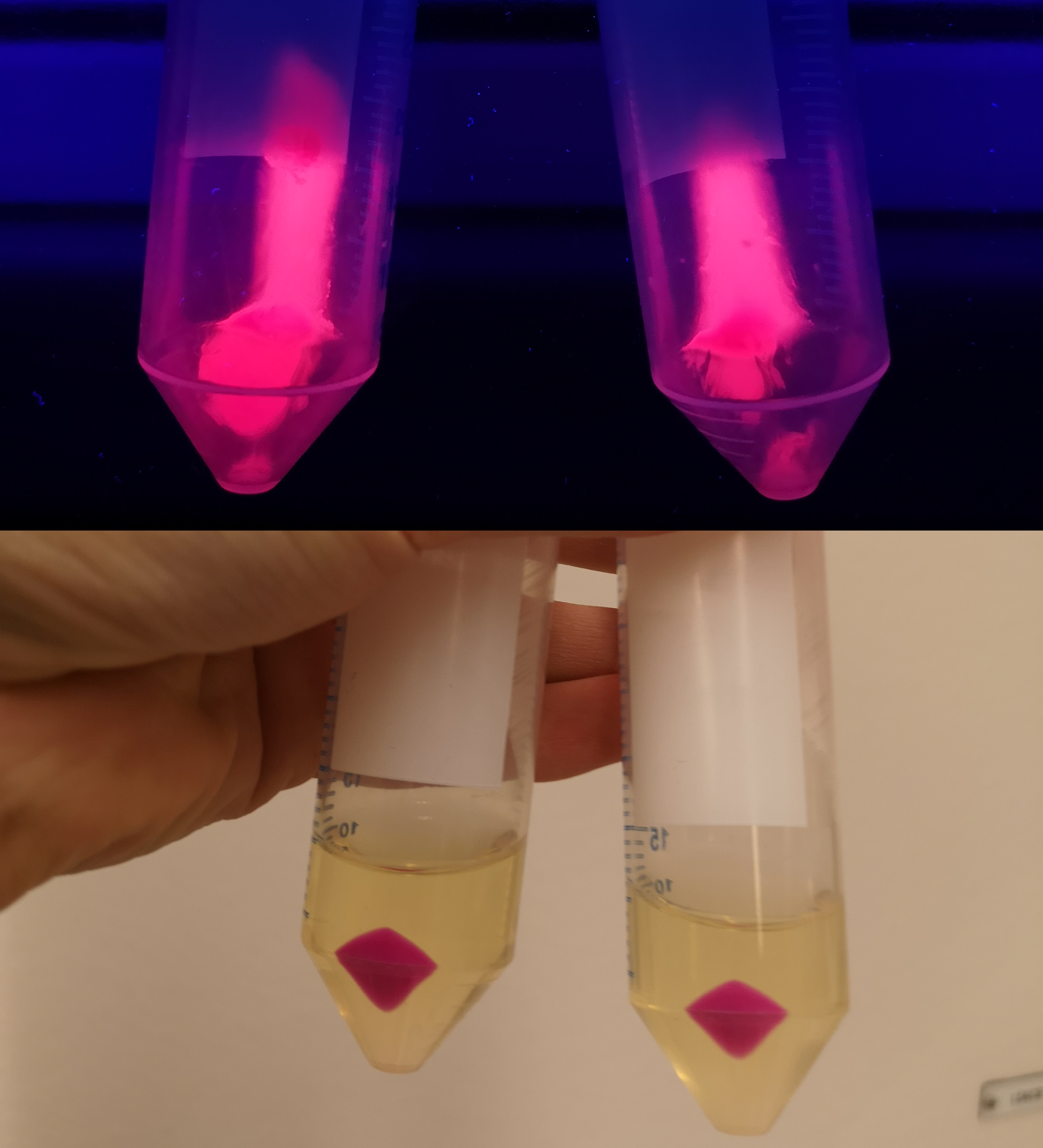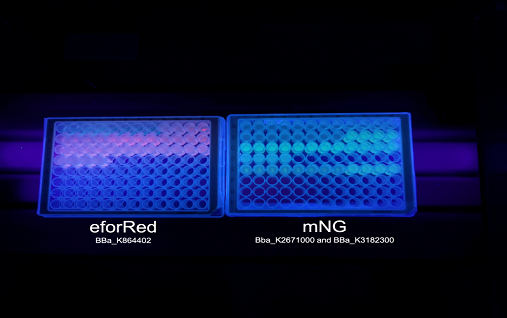Difference between revisions of "Part:BBa K864402:Experience"
| Line 13: | Line 13: | ||
[[Image:T--Linkoping_Sweden--eforred-pellet-photo.png|400px]] | [[Image:T--Linkoping_Sweden--eforred-pellet-photo.png|400px]] | ||
<br><br> | <br><br> | ||
| − | <i><b>Figure 1.</b></i> <b>To the left</b> This biobrick after 48 hours in 37 degrees Celsius (both pictures). To the left is cultured E. coli BL21 cells with this biobrick in white light. The culture tubes had a constant supply of oxygen (cotton plugs) which is important for the chromophore/fluorophore of eforRed to develop. <b>In the bottom right </b> a culture of BL21 (DE3) Gold which has been incubated for 48 hours in 37 degrees Celsius has been centrifuged at 12 000 g for 10 min. The result is a pellet of eforRed expressing bacteria with a burgundy color. The same pellet in the <b>top right </b> was put on a UV table (302 nm) which resulted in a pink glowing pellet. | + | <i><b>Figure 1.</b></i> <b>To the left</b> This biobrick after 48 hours in 37 degrees Celsius (both pictures). To the left is cultured E. coli BL21 (DE3) Gold cells with this biobrick in white light. The culture tubes had a constant supply of oxygen (cotton plugs) which is important for the chromophore/fluorophore of eforRed to develop. <b>In the bottom right </b> a culture of BL21 (DE3) Gold which has been incubated for 48 hours in 37 degrees Celsius has been centrifuged at 12 000 g for 10 min. The result is a pellet of eforRed expressing bacteria with a burgundy color. The same pellet in the <b>top right </b> was put on a UV table (302 nm) which resulted in a pink glowing pellet. |
<br><br> | <br><br> | ||
[[Image:T--Linkoping_Sweden--eforred-agar-photo.png|center|600px]] | [[Image:T--Linkoping_Sweden--eforred-agar-photo.png|center|600px]] | ||
| − | <b> | + | <b><i>Figure 2.</i></b> Ccolonies in the same host as previously in figure 1 is illuminated in 302 nm UV-light, showing eforReds ability to also emit strong fluorescence. |
<br><br> | <br><br> | ||
Revision as of 08:45, 27 August 2019
This experience page is provided so that any user may enter their experience using this part.
Please enter
how you used this part and how it worked out.
Applications of BBa_K864402
2019 iGEM team Linkoping Sweden
2019 iGEM team Linkoping Sweden validated this part.


Figure 1. To the left This biobrick after 48 hours in 37 degrees Celsius (both pictures). To the left is cultured E. coli BL21 (DE3) Gold cells with this biobrick in white light. The culture tubes had a constant supply of oxygen (cotton plugs) which is important for the chromophore/fluorophore of eforRed to develop. In the bottom right a culture of BL21 (DE3) Gold which has been incubated for 48 hours in 37 degrees Celsius has been centrifuged at 12 000 g for 10 min. The result is a pellet of eforRed expressing bacteria with a burgundy color. The same pellet in the top right was put on a UV table (302 nm) which resulted in a pink glowing pellet.
Figure 2. Ccolonies in the same host as previously in figure 1 is illuminated in 302 nm UV-light, showing eforReds ability to also emit strong fluorescence.


Figure 2. To the left is a spectrophotometric experiment where varying levels of oxygen supply were tested. The holes were made in the plastic cover of a 96-well plate and run for 16 hours in 37 degrees Celsius, this results shows the oxygen dependency of eforReds chromophore/fluorophore development. To the right is this biobrick in a 96-well plate, the culture has been in the well O.N in 37 degrees Celsius with varying levels of oxygen supply. The plate to the right is different expression systems used to test a strong green/yellow fluorescent protein. These results show eforReds ability to fluorescence, making it a fluorescent as well as a chromoprotein. Both plates were illuminated in 302 nm UV-light.
User Reviews
UNIQ1379bfeed339626e-partinfo-00000000-QINU UNIQ1379bfeed339626e-partinfo-00000001-QINU


